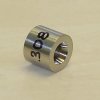“Case gauges are very useful - assuming your chamber (and the gauge) are both within specifications”
I am sure everyone understands what all of that means, well? Almost. First, it must be understood “Visit our website at
WWW.LARRYWILLIS.COM it's devoted to helping shooters make the best handloads possible” is trying to sell something. The Wilson case gage is ‘IN SPECIFICATION’ the Wilson case gage is a datum based tool, I know all of you have heard the term ‘DUMMY ROUND’, like the Wilson case gage, it depends on who is using it.
“ However, it's always best to measure how YOUR handloads fit in YOUR particular chamber” Back to ‘SPECIFICATIONS’ AND CONFUSION. LARRY WILLIS MAKES A TOOL HE REFERS TO AS BEING A DIGITAL HEAD SPACE GAGE, in all appearance it looks like a comparator, as in measure before and again after then compare the difference, and then? (Along came John) measure again after sizing to determine the effect sizing had on the case length from the shoulder to the head of the case.
Back to 'ASSUMING’ The L.E. Wilson case gage is in specification, it has a datum (measured from), when a case (30/06) is placed into the Wilson case gage the case sits on on a datum/round hole of .375”, again, there is no shoulder in the gage for the shoulder to sit on, there is only the datum/round hole with a radius. The distance from the datum to the head of the case is minimum length when measured to the bottom of the low deck, the distance from the datum to the high deck is is go-gage length.
That leaves the other measurement as in ‘specifications’, from the datum to the mouth of the case (At this point I am beginning to believe no one understands the opening statement). There are case trimmers that are set up to trim off of the shoulder of the case, meaning case length is not part of the specifications and it is assumed a reloader understands there are two length of the chamber, one from the datum/shoulder to the bolt face of the chamber and the other from the datum/shoulder to the mouth of the chamber.
again, I have an Eddystone M1917 that has a long chamber, it has .016” added between the shoulder and bolt face, problem? No, I add .014” to the length of the case between the shoulder and head of the case, ‘And then’ I add .014” to the length of the case for trimming.
What does all of this mean when checking my cases for the Eddystone M1917? The case will protrude from the Wilson case gage .014” above the low deck of the Wilson case gage and .009” above the high deck.
And then? I ask about the case mouth at the opposite end of the gage?
For those with dial calipers, measure the length of the Wilson case gage, THEN!? compare the length of the gage with case length specifications.
F. Guffey







